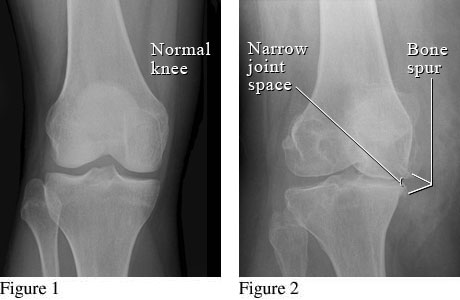What is knee arthritis?
Arthritis is the breakdown of tissue (cartilage) that cushions your joint. It can cause pain and stiffness. Knee arthritis happens when the cartilage in your knee joint wears down. This can cause the bones to rub together.
What are the symptoms of knee arthritis?
Symptoms can be mild to severe. They may include pain and stiffness in the knee. You may feel stiff when you get up in the morning. You may have trouble walking. Your knee may look swollen or deformed, and it may make creaking or cracking sounds.
X-Ray of Osteoarthritis of the Knee

Courtesy of Intermountain Medical Imaging, Boise, Idaho.
Figure 1 is an X-ray of a normal knee with normal space between the bones of the upper and lower leg. Figure 2 shows bone spurs and a narrowed joint space caused by osteoarthritis.
Knee Arthritis: Nonsurgical Treatments
How can you care for yourself when you have knee arthritis?
- Know that knee arthritis will cause more pain on some days than on others.
- Stay at a healthy weight. Lose weight if you are overweight. When you stand up, the pressure on your knees from every pound of body weight is multiplied four times. So if you lose 10 pounds, you will reduce the pressure on your knees by 40 pounds.
- Talk to your doctor or physical therapist about exercises that will help ease joint pain.
- Stretch to help prevent stiffness and to prevent injury before you exercise. You may enjoy gentle forms of yoga to help keep your knee joints and muscles flexible.
- Walk instead of jog.
- Ride a bike. This makes your thigh muscles stronger and takes pressure off your knee.
- Wear well-fitting and comfortable shoes.
- Exercise in chest-deep water. This can help you exercise longer with less pain.
- Avoid exercises that include squatting or kneeling. They can put a lot of strain on your knees.
- Talk to your doctor to make sure that the exercise you do is not making the arthritis worse.
- Do not sit for long periods of time. Try to walk once in a while to keep your knee from getting stiff.
- Ask your doctor or physical therapist whether shoe inserts may reduce your arthritis pain.
- If you can afford it, get new athletic shoes at least every year. This can help reduce the strain on your knees.
- Use a device to help you do everyday activities.
- A cane or walking stick can help you keep your balance when you walk. Hold the cane or walking stick in the hand opposite the painful knee.
- If you feel like you may fall when you walk, try using crutches or a front-wheeled walker. These can prevent falls that could cause more damage to your knee.
- A knee brace may help keep your knee stable and prevent pain.
- You also can use other things to make life easier, such as a higher toilet seat and handrails in the bathtub or shower.
- Take pain medicines exactly as directed.
- Do not wait until you are in severe pain. You will get better results if you take it sooner.
- If you are not taking a prescription pain medicine, take an over-the-counter medicine such as acetaminophen (Tylenol), ibuprofen (Advil, Motrin), or naproxen (Aleve). Read and follow all instructions on the label.
- Do not take two or more pain medicines at the same time unless the doctor told you to. Many pain medicines have acetaminophen, which is Tylenol. Too much acetaminophen (Tylenol) can be harmful.
- Tell your doctor if you take a blood thinner, have diabetes, or have allergies to shellfish.
- Ask your doctor if you might benefit from a shot of steroid medicine into your knee. This may provide pain relief for several months.
- Many people take the supplements glucosamine and chondroitin for osteoarthritis. Some people feel they help, but the medical research does not show that they work. Talk to your doctor before you take these supplements.
Knee arthritis: When to call
Call your doctor now or seek immediate medical care if:
- You have sudden swelling, warmth, or pain in your knee.
- You have knee pain and a fever or rash.
- You have such bad pain that you cannot use your knee.
Watch closely for changes in your health, and be sure to contact your doctor if you have any problems.
©2011-2025 Healthwise, Incorporated
